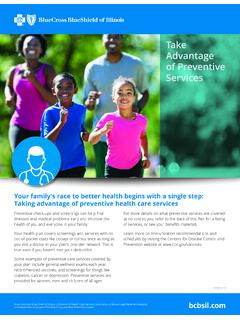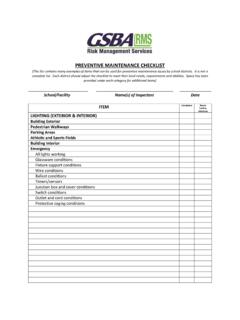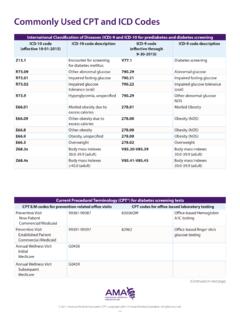Transcription of Cardiovascular Disease Prevention and Control
1 Cardiovascular Disease refers to several types of conditions that affect the heart and blood vessels. Cardiovascular diseases, including heart Disease and stroke, account for one-third of all deaths and contribute an estimated $315 billion annually in healthcare costs and lost , 2 Many Cardiovascular Disease risk factors, such as high blood pressure, high cholesterol, excess weight, poor diet, smoking and diabetes, can be prevented or treated through behavior change and appropriate This brochure is designed to help public health program planners, community advocates, educators, primary care providers and policymakers find proven intervention strategies including programs, services and policies to plan evidence-based care that has been proven to reduce patients risk for Cardiovascular Disease . It can help decision makers in both public and private sectors make choices about what intervention strategies are best for their communities.
2 This brochure summarizes information in The Guide to Community preventive Services (The Community Guide), an essential resource for people who want to know what works in public health. Use the information in this brochure to help select from the following intervention strategies you can use in your community and healthcare organizations: zIntroduce clinical decision-support systems within healthcare systems to implement clinical guidelines at the point of care. zReduce out-of-pocket costs for medications to Control high blood pressure and high cholesterol in patients. zIncorporate multidisciplinary team-based care within healthcare systems, including the patient, the primary care provider, and other professionals such as nurses, pharmacists, dietitians, social workers and community health workers, in order to improve blood pressure Community Guide provides evidence-based findings and recommendations from the Community preventive Services Task Force (Task Force) about community preventive services, programs, and policies to improve health.
3 Learn more about The Community Guide and what works to prevent Cardiovascular Disease by visiting Centers for Disease Control and Prevention provides administrative, research, and technical support for the Community preventive Services Task Disease Prevention and ControlEvidence-Based Interventions for Your CommunityCardiovascular Disease Prevention and ControlThe Guide to Community preventive Services (The Community Guide) is an essential resource for people who want to know what works in public health. It provides evidence-based recommendations and findings about public health interventions and policies to improve health and promote safety. The Community preventive Services Task Force (Task Force) an independent, nonfederal, unpaid body of public health and Prevention experts bases its findings and recommendations on systematic reviews of the scientific literature. With oversight from the Task Force, scientists and subject matter experts from the Centers for Disease Control and Prevention conduct these reviews in collaboration with a wide range of government, academic, policy, and practice-based partners.
4 EVALUATING THE EVIDENCEz The Task Force findings and recommendations for interventions that prevent Cardiovascular Disease are based on systematic reviews of the available evidence. z The systematic reviews look at the results of research and evaluation studies published in peer-reviewed journals and other Each systematic review looks at the intervention strategy s effectiveness and how it works in different populations and settings. If found effective, cost and return on investment are also reviewed when available. z For each intervention strategy, a summary of the systematic review, evidence gaps, and journal publications can be found on the Cardiovascular Disease section of the website at information about how the Task Force conducts its reviews is available at THE PUBLIC HEALTH CHALLENGEC ardiovascular Disease is the leading cause of death globally4z Nearly 800,000 people die in the each year from Cardiovascular diseases that s almost 1 out of every 3 Approximately every 1 minute and 23 seconds, an American will die from a coronary Almost half of Americans exhibit at least one of three key Cardiovascular Disease risk factors including hypertension, uncontrolled high levels of low-density lipoprotein cholesterol and Smoking, physical inactivity.
5 And poor diet increase the risk of Cardiovascular z About 1 in 3 adults or 71 million people have high blood High blood pressure can be dangerous because it typically does not have any Less than half (48%) of individuals with high blood pressure do not have their blood pressure under An estimated 46,000 deaths might be averted each year of 70% of patients under the age of 80 with high blood pressure were treated according to goals established in current clinical For more about Cardiovascular Disease Prevention and Control , visit High blood pressure is a leading cause of heart Disease and stroke in the Source: : THE FINDINGS ON Cardiovascular DISEASEAll Task Force findings and recommendations on preventing Cardiovascular Disease are available online at Some of the Task Force recommendations related to preventing Cardiovascular Disease are below. Implementing Clinical Decision-Support Systems at the point-of-care.
6 Provider practices related to screening for Cardiovascular Disease risk factors and for Cardiovascular Disease -related preventive care services, clinical tests and treatments can be improved through the use of clinical decision-support systems. These computer-based information systems are designed to assist healthcare providers by providing patient-specific information during healthcare visits. Clinical decision-support systems allow healthcare providers to screen for Cardiovascular Disease risk factors, assess a patient s risk for developing Cardiovascular Disease , and alert patients during visits when health indicators for Cardiovascular Disease risk factors are elevated. Reducing out of pocket costs for patients. Reducing out-of-pocket costs for medications to Control high blood pressure and high cholesterol can be implemented alone or in combination with other interventions including team-based care.
7 In addition, reducing out-of-pocket costs can increase medication adherence, which subsequently helps increase the proportion of patients that meet the recommended blood pressure goal by a median of 18 percentage points, as well as a median increase of 13 percentage points for the proportion of patients who meet the recommended cholesterol goal. Incorporating team-based care in health systems. Team-based care consists of a healthcare team that works together to improve patient care. The coordinated team includes the patient, the patient s primary care provider, as well as other health professionals ( , nurses, pharmacists and dietitians). Team-based care interventions allow for communication between team members, the use of clinical guidelines by team members, consistent monitoring of patient progress, and engagement of patients in their own care. This can reduce Cardiovascular Disease risk by improving blood pressure Control .
8 Healthcare systems that used team-based care increased the proportion of patients with controlled blood pressure by a median of 12 percentage points when compared to usual care. PUTTING THE TASK FORCE FINDINGS TO WORKAs a public health decision maker, practitioner, community leader, or someone who can influence the health of your community, you can use The Community Guide to create a blueprint for success. See how other communities have applied the Task Force recommendations for Cardiovascular Disease Prevention and Control at Get ideas from their Community Guide in Action stories. Visit the Department of Health and Human Services Million Hearts initiative at to identify ways to reduce Cardiovascular Disease risk across the COMMUNITY GUIDE IN ACTIONFOR MORE INFORMATION Division of Heart Disease and Stroke Prevention , Prevention Status Report Heart Disease and Stroke Heart, Lung, and Blood Institute, Hearts Campaign Heart Association Health Organization Permanente Colorado Implements Hypertension Management ProgramWith more than 85,000 adult patients diagnosed with high blood pressure in the Denver metropolitan area alone, Kaiser Permanente Colorado implemented several evidence-based strategies aimed at increasing the hypertension Control rate within its patient population.
9 The Hypertension Management Program emphasizes a team-based, integrated approach to care for patients with high blood pressure, utilizing some of the strategies recommended in The Community Guide. This includes creating registries that care teams can use to help individuals proactively manage their blood pressure and other chronic diseases. As a result of these changes, hypertension Control rates rose from just over 61 percent in January 2008 to nearly 83 percent by fall 2012. West End Medical Centers Implements Patient-Centered Medical Home ModelWest End Medical Centers, Inc. (WEMC) provides comprehensive primary healthcare services in seven locations throughout Georgia s Fulton and Cobb counties. WEMC is a patient-centered medical home and a nonprofit organization of federally qualified health centers. WEMC s patient population is predominantly African American, female and nearly half are uninsured. WEMC s care model utilizes many of the strategies recommended by The Community Guide, including a focus on physician-led provider teams who work with patients to develop and manage their hypertension.
10 Patients with uncontrolled blood pressure receive referrals for additional care and support services, including medications, access to a dietician, and fitness instruction as part of a health education program. As a result of these changes, 63 percent of WEMC s 4,000 hypertensive patients had controlled blood pressure by 2012. REFERENCES1. Centers for Disease Control and Prevention DHDSP. Heart Disease Fact Sheet. 2014; Available from: Go AS, Mozaffarian D, Roger VL, Benjamin EJ, Berry JD, Blaha MJ, et al. Heart Disease and stroke statistics--2014 update: a report from the American Heart Association. Circulation 2014;129(3):e28-e292. 3. Centers for Disease Control and Prevention DHDSP. Heart Disease Fact Sheet. 2014; Available from: Alwan A. Global status report on noncommunicable diseases 2010. World Health Organization; Deaths: Final Data for 2012. Forthcoming Natl Vital Stat Rep. 2014;63(9).6. Million hearts: strategies to reduce the prevalence of leading Cardiovascular Disease risk factors--United States, 2011.














